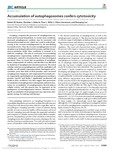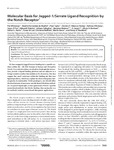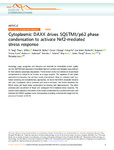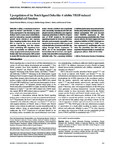Accumulation of autophagosomes confers cytotoxicity

Date
2017-07-03Author
Subject
Metadata
Show full item recordAbstract
Autophagy comprises the processes of autophagosome synthesis and lysosomal degradation. In certain stress conditions, increased autophagosome synthesis may be associated with decreased lysosomal activity, which may result in reduced processing of the excessive autophagosomes by the rate-limiting lysosomal activity. Thus, the excessive autophagosomes in such situations may be largely unfused to lysosomes, and their formation/accumulation under these conditions is assumed to be futile for autophagy. The role of cytotoxicity in accumulating autophagosomes (representing synthesis of autophagosomes subsequently unfused to lysosomes) has not been investigated previously. Here, we found that accumulation of autophagosomes compromised cell viability, and this effect was alleviated by depletion of autophagosome machinery proteins. We tested whether reduction in autophagosome synthesis could affect cell viability in cell models expressing mutant huntingtin and α-synuclein, given that both of these proteins cause increased autophagosome biogenesis and compromised lysosomal activity. Importantly, partial depletion of autophagosome machinery proteins Atg16L1 and Beclin 1 significantly ameliorated cell death in these conditions. Our data suggest that production/accumulation of autophagosomes subsequently unfused to lysosomes (or accumulation of autophagosomes) directly induces cellular toxicity, and this process may be implicated in the pathogenesis of neurodegenerative diseases. Therefore, lowering the accumulation of autophagosomes may represent a therapeutic strategy for tackling such diseases.
Collections
Publisher
Place of Publication
Journal
Volume
Issue
Pagination
Author URL
Recommended, similar items
The following license files are associated with this item:
Related items
Showing items related by title, author, creator and subject.
-
Molecular Basis for Jagged-1/Serrate Ligand Recognition by the Notch Receptor
Whiteman, P; de Madrid, BH; Taylor, P; Li, D; Heslop, R; Viticheep, N; Tan, JZ; Shimizu, H; Callaghan, J; Masiero, M; Li, JL; Banham, AH; Harris, AL; Lea, SM; Redfield, C; Baron, M; Handford, PA (Elsevier BVUnited States, 2013-03)We have mapped a Jagged/Serrate-binding site to specific residues within the 12th EGF domain of human and Drosophila Notch. Two critical residues, involved in a hydrophobic interaction, provide a ligand-binding platform ... -
Cytoplasmic DAXX drives SQSTM1/p62 phase condensation to activate Nrf2-mediated stress response
Yang, Y; Willis, TL; Button, RW; Strang, CJ; Fu, Y; Wen, X; Grayson, PRC; Evans, T; Sipthorpe, RJ; Roberts, SL; Hu, B; Zhang, J; Lu, B; Luo, S (Springer Science and Business Media LLCEngland, 2019-08-21)<jats:title>Abstract</jats:title><jats:p>Autophagy cargo recognition and clearance are essential for intracellular protein quality control. SQSTM1/p62 sequesters intracellular aberrant proteins and mediates cargo delivery ... -
Up-regulation of the Notch ligand Delta-like 4 inhibits VEGF-induced endothelial cell function
Williams, CK; Li, J-L; Murga, M; Harris, AL; Tosato, G (American Society of HematologyUnited States, 2006-02-01)<jats:title>Abstract</jats:title><jats:p>Delta-like 4 (Dll4), a membrane-bound ligand for Notch1 and Notch4, is selectively expressed in the developing endothelium and in some tumor endothelium, and it is induced by ...




